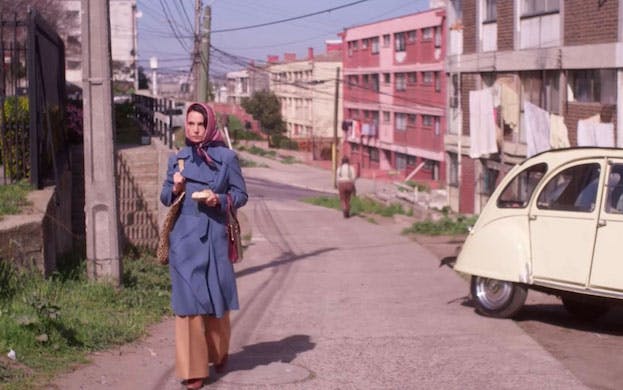Psychological Thriller ‘Chile ’76’ Paints a Bleak Picture of Life Under Pinochet
Dialogue and scenes involving politics are few, mirroring how Pinochet prohibited public discourse of governmental affairs. Even private discussion amongst family and close friends is shown creating deep unease.

As a color, pink has been hot for several years now, from the so-called millennial pink of a few years ago to the “Barbie” pink of the upcoming movie. In terms of impact, though, one might never see the color in the same way after watching “Chile ’76.” Referenced in the movie’s mise-en-scène (wall color, cake frosting, etc.), via light filters, and even the title sequence, myriad tones of pink denote danger, uncertainty, and vulnerability, conditions that match its depiction of Chile after Pinochet’s coup.
The movie immerses the viewer in an anxious atmosphere — and announces its formal qualities through its expressive use of color, sound, and framing — in the first scene: lead character Carmen is in a hardware shop trying to get the paint-mixing attendant to match a certain Venetian shade of pink when outside a woman screams as she’s taken away by government forces.
We never see what happens on the street, as the filmmakers don’t cut to it, confirming that much of what we’re about to witness is from a singular perspective (Carmen’s). As in some of the best psychological thrillers, a limited point-of-view brings us closer to the mindset of a main character in crisis, and the filmmakers of “Chile ‘76” make the most of this technique, even if they don’t stick to it completely (as few films can).
Carmen is an elegant, well-to-do grandmother — surely one of the chicest we’ve seen in cinema in recent years — and the pink paint she buys is for the interior of her summer house, which is being renovated and where her husband, children, and grandchildren will be heading during the winter weekends. Before her family arrives, she drives to the house with their live-in maid to oversee the work. But the seaside town’s local priest has other plans for her, and soon Carmen is tending to the gunshot wound of a young political rebel named Elías.
I say “political,” though dialogue and scenes involving politics are few, mirroring how Pinochet prohibited public discourse of governmental affairs. Even private discussion amongst family and close friends creates deep unease, as seen in a tense dinner table scene in which an accusation of wasteful government and a retort about problematic privatization are quickly swatted away.
This reticence and aversion to all things political doesn’t stop Carmen, though, from acting as a liaison between Elías, who’s still healing, and his resistance cohorts. As she involves herself further in these covert activities — while simultaneously taking care of her grandkids, volunteering for the blind, and generally looking fabulous — the foreboding increases, leading to a moment both supremely suspenseful and banal. Pink and its “pinko” connotations play a key visual role.
Pink isn’t the only color the filmmakers explore. First-time director Manuela Martelli and her cinematographer, Yarará Rodríguez, employ a range of blues to pinpoint the national mood of sadness and emotional apathy. Their unsettling use of two colors we normally associate with gender roles — pink equals placid and passive, blue strong and assertive — demonstrates how Ms. Martelli and her creative crew effectively address issues of patriarchy.
Occasionally, they also use shots of Carmen reflected in mirrors or glimpsed through windows not only to illustrate the fear of being watched, but to show how she compartmentalizes her actions. Along with other artful compositions, these shots betray the narrative’s character point-of-view so that the filmmakers can also allude to, with economy and precision, profound ironies and symbolic meanings on the nature of living under authoritarian rule.
As Carmen, the Chilean actress Aline Küppenheim is a revelation. Dressed impeccably, and coiffed and made-up tastefully, the character must reflect at all times an upper class demeanor of self-control and subtlety. Ms. Küppenheim never puts a foot wrong. We’re led to believe that she medicates herself with booze and pills, and yet the actress is able to demonstrate how Carmen remains clear-eyed and driven, particularly when she is nursing Elías and when going on one of her secret missions.
At one point, Carmen is dubbed “Cleopatra” by a resistance fighter and it’s an apt description of Ms. Küppenheim’s mysterious mien. Some might deem the ending of “Chile ‘76” anti-climactic, seemingly shielding its heroine from more peril. Yet most viewers will remember the character’s courageous composure, how one woman — going against all she was taught and raised amongst — risked everything to help someone in need. Even if, ultimately, she’s powerless to the many forces of oppression who draw deep red blood.

